Computing the Growth of Small Cracks in the Assist Round Robin Helicopter Challenge
Abstract
1. Introduction
2. Materials and Methods
3. Crack Growth in 7075-T7351
3.1. Crack Growth under a FALSTAFF Flight Load Spectrum
3.2. Short Cracks in 7075-T7351
4. Computing Crack Growth in the DST Small Crack Helicopter Round Robin Challenge
Short Cracks in 7075-T7351
5. Material Variability
On the Shape of the Crack Depth History Curves
6. Conclusions
Author Contributions
Funding
Acknowledgments
Conflicts of Interest
References
- Lincoln, J.W.; Melliere, R.A. Economic life determination for a military aircraft. J. Aircr. 1999, 36, 737–742. [Google Scholar] [CrossRef]
- Jones, R. Fatigue crack growth and damage tolerance. Fatigue Fract. Eng. Mater. Struct. 2014, 37, 463–483. [Google Scholar] [CrossRef]
- MIL-STD-1530D, Department of Defense Standard Practice Aircraft Structural Integrity Program (ASIP). 13 October 2016. Available online: http://everyspec.com/MIL-STD/MIL-STD.../download.php?spec=MIL-STD-1530D (accessed on 2 February 2020).
- ASTM E647-13a. Measurement of Fatigue Crack Growth Rates; ASTM: West Conshohocken, PA, USA, 2013. [Google Scholar]
- Newman, J.C.; Irving, P.; Lin, J.; Le, D. Crack growth in a complex helicopter component under spectrum loading. Fatigue Fract. Eng. Mater. Struct. 2006, 29, 949–958. [Google Scholar] [CrossRef]
- Irving, P.; Lin, J.; Bristow, J. Damage tolerance in helicopters—Report on the round-robin challenge. In Proceedings of the American Helicopter Society 59th Annual Forum, Phoenix, AR, USA, 6–8 May 2003; Available online: https://vtol.org/store/product/a-round-robin-exercise-to-assess-capability-topredict-crack-growth-lives-and-inspection-intervals-for-damage-tolerant-design-in-helicopters-4262.cfm (accessed on 29 May 2020).
- Peng, D.; Jones, R.; Sinha, A.; Mathews, N.; Singh Raman, R.K.; Phan, N.T.; Nguyen, T. Analysis of fatigue crack growth in a helicopter component. In Proceedings of the Asian/Australian Rotorcraft Forum 2018, Seogwipo City, Jeju Island, Korea, 30 October–1 November 2018; Available online: https://vtol.org/arf2018 (accessed on 29 May 2020).
- Cansdale, R.; Perrett, B. The Helicopter Damage Tolerance Round Robin Challenge. In Proceedings of the Workshop on Fatigue Damage of Helicopters, Pisa, Italy, 12–13 September 2002. [Google Scholar]
- Department of Defense Joint Service Specification Guide, Aircraft Structures, JSSG-2006. October 1998. Available online: http://everyspec.com/USAF/USAF-General/JSSG-2006_10206/ (accessed on 10 July 2020).
- Structures Bulletin EZ-SB-19-01, Durability and Damage Tolerance Certification for Additive Manufacturing of Aircraft Structural Metallic Parts, Wright Patterson Air Force Base, OH, USA. 10 June 2019. Available online: https://daytonaero.com/usaf-structures-bulletins-library/ (accessed on 2 February 2020).
- Burchill, M. Advancing Structural Simulation to Drive Innovative Sustainment Technologies: ASSIST Helicopter Crack Growth Prediction Challenge Definition. 18 June 2019. Available online: https://www.researchgate.net/publication/341790926_Approved_for_Public_Release_Advancing_Structural_Simulation_to_drive_Innovative_Sustainment_Technologies_ASSIST_Helicopter_Crack_Growth_Prediction_Challenge_Definition?channel=doi&linkId=5ed4f110458515294527add2&showFulltext=true (accessed on 16 May 2020).
- ASSIST Challenge 3. Available online: https://www.researchgate.net/publication/342201234_Spectra (accessed on 16 May 2020).
- Hartman, A.; Schijve, J. The effects of environment and load frequency on the crack propagation law for macro fatigue crack growth in aluminium alloys. Eng. Fract. Mech. 1970, 1/4, 615–631. [Google Scholar] [CrossRef]
- Lo, M.; Jones, R.; Bowler, A.; Dorman, M.; Edwards, D. Crack growth at fastener holes containing intergranular cracking. Fatigue Fract. Eng. Mater. Struct. 2017, 40, 1664–1675. [Google Scholar] [CrossRef]
- Tamboli, D.; Barter, S.; Jones, R. On the growth of cracks from etch pits and the scatter associated with them under a miniTWIST spectrum. Int. J. Fatigue 2018, 109, 10–16. [Google Scholar] [CrossRef]
- Jones, R.; Molent, L.; Barter, S. Calculating crack growth from small discontinuities in 7050-T7451 under combat aircraft spectra. Int. J. Fatigue 2013, 55, 178–182. [Google Scholar] [CrossRef]
- Main, B.; Evans, R.; Walker, K.; Yu, X.; Molent, L. Lessons from a Fatigue Prediction Challenge for an Aircraft Wing Shear Tie Post. Int. J. Fatigue 2019, 123, 53–65. [Google Scholar] [CrossRef]
- Jones, R.; Singh Raman, R.K.; McMillan, A.J. Crack growth: Does microstructure play a role? Eng. Fracture Mech. 2018, 187, 190–210. [Google Scholar] [CrossRef]
- Zhang, Y.; Zheng, K.; Heng, J.; Zhu, J. Corrosion-Fatigue Evaluation of Uncoated Weathering Steel Bridges. Appl. Sci. 2019, 9, 3461. [Google Scholar] [CrossRef]
- Godefroid, L.B.; Moreira, L.P.; Vilela, T.C.G.; Faria, G.L.; Candido, L.C.; Pinto, E.S. Effect of chemical composition and microstructure on the fatigue crack growth resistance of pearlitic steels for railroad application. Int. J. Fatigue 2019, 120, 241–253. [Google Scholar] [CrossRef]
- Cano, A.J.; Salazar, A.; Rodríguez, J. Evaluation of different crack driving forces for describing the fatigue crack growth behaviour of PET-G. Int. J. Fatigue 2018, 107, 27–32. [Google Scholar] [CrossRef]
- Jones, R.; Peng, D.; Michopoulos, J.G.; Kinloch, A.J. Requirements and Variability Affecting the Durability of Bonded Joints. Materials 2020, 23, 1468. [Google Scholar] [CrossRef]
- Jones, R.; Hu, W.; Kinloch, A.J. A convenient way to represent fatigue crack growth in structural adhesives. Fatigue Fract. Eng. Mater. Struct. 2015, 38, 379–391. [Google Scholar] [CrossRef]
- Jones, R.; Kinloch, A.J.; Hu, W. Cyclic-fatigue crack growth in composite and adhesively-bonded structures: The FAA slow crack growth approach to certification and the problem of similitude. Int. J. Fatigue 2016, 88, 10–18. [Google Scholar] [CrossRef]
- Rocha, A.V.M.; Akhavan-Safar, A.; Carbas, R.; Marques, E.A.S.; Goyal, R.; El-Zein, M.; da Silva, L.F.M. Paris law relations for an epoxy-based adhesive. Proc. Inst. Mech. Eng. Part L J. Mater. Des. Appl. 2019. [Google Scholar] [CrossRef]
- Brunner, A.J.; Stelzer, S.; Pinter, G.; Terrasi, G.P. Cyclic fatigue delamination of carbon fiber-reinforced polymer-matrix composites: Data analysis and design considerations. Int. J. Fatigue 2016, 83, 293–299. [Google Scholar] [CrossRef]
- Chocron, T.; Banks-Sills, L. Nearly mode I fracture toughness and fatigue delamination propagation in a multidirectional laminate fabricated by a wet-layup. Phys. Mesomech. 2019, 22, 107–140. [Google Scholar] [CrossRef]
- Simon, I.; Banks-Sills, L.; Fourman, V. Mode I delamination propagation and R-ratio effects in woven composite DCB specimens for a multi-directional layup. Int. J. Fatigue 2017, 96, 237–251. [Google Scholar] [CrossRef]
- Jones, R.; Kinloch, A.J.; Michopoulos, J.G.; Brunner, A.J.; Phan, N. Delamination growth in polymer-matrix fibre composites and the use of fracture mechanics data for material characterisation and life prediction. Compos. Struct. 2017, 180, 316–333. [Google Scholar] [CrossRef]
- Yao, L.; Alderliesten, R.C.; Jones, R.; Kinloch, A.J. Delamination fatigue growth in polymer-matrix fibre composites: A methodology for determining the design and lifing allowables. Compos. Struct. 2018, 196, 8–20. [Google Scholar] [CrossRef]
- Jones, R.; Stelzer, S.; Brunner, A.J. Mode I, II and Mixed Mode I/II delamination growth in composites. Compos. Struct. 2014, 110, 317–324. [Google Scholar] [CrossRef]
- Simon, I.; Banks-Sills, L.; Fourman, V.; Eliasi, R. Delamination Propagation and Load Ratio Effects in DCB MD Woven Composite Specimens. Procedia Struct. Integr. 2016, 2, 205–212. [Google Scholar] [CrossRef][Green Version]
- Schwalbe, K.H. On the beauty of analytical models for fatigue crack propagation and fracture—A personal historical review. In Fatigue and Fracture Mechanics: 37th Volume; ASTM International: West Conshohocken, PA, USA, 2011; pp. 3–73. [Google Scholar] [CrossRef]
- Jones, R.; Michopoulos, J.G.; Iliopoulos, A.P.; Raman, R.S.; Phan, N.; Nguyen, T. Representing crack growth in additively manufactured Ti-6Al-4V. Int. J. Fatigue 2018, 116, 610–622. [Google Scholar] [CrossRef]
- Jones, R.; Sing Raman, R.K.; Iliopoulos, A.P.; Michopoulos, J.; Phan, N.; Peng, D. Additively manufactured Ti-6Al-4V replacement parts for military aircraft. Int. J. Fatigue 2019, 124, 227–235. [Google Scholar] [CrossRef]
- Iliopoulos, A.P.; Jones, R.; Michopoulos, J.; Phan, N.; Singh Raman, R.K. Crack growth in a range of additively manufactured aerospace structural materials. Aerospace 2018, 5, 118. [Google Scholar] [CrossRef]
- Iliopoulos, A.P.; Jones, R.; Michopoulos, J.G.; Phan, N.; Rans, C. Further Studies into Crack Growth in Additively Manufactured Materials. Materials 2020, 13, 2223. [Google Scholar] [CrossRef]
- Jones, R.; Molaei, R.; Fatemi, A.; Peng, D.; Phan, N. A note on computing the growth of small cracks in AM Ti-6Al-4V. In Proceedings of the 1st Virtual European Conference on Fracture (VECF1), 29 June 2020; Available online: https://www.youtube.com/watch?v=W8rTAREK7ak&feature=youtu.be (accessed on 31 May 2020).
- Kundu, S.; Jones, R.; Peng, D.; Matthews, N.; Alankar, A.; Singh Raman, R.K.; Huang, P. Review of requirements for the durability and damage tolerance certification of additively manufactured aircraft structural parts and AM repairs. Materials 2020, 13, 1341. [Google Scholar] [CrossRef]
- Under Secretary, Acquisition and Sustainment, Directive-Type Memorandum (DTM)-19-006-Interim Policy and Guidance for the Use of Additive Manufacturing (AM) in Support of Materiel Sustainment, Pentagon, Washington, DC. 21 March 2019. Available online: https://www.esd.whs.mil/Portals/54/Documents/DD/issuances/dtm/DTM-19-006.pdf?ver=2019-03-21-075332-443 (accessed on 2 February 2020).
- Zhuang, W.; Liu, Q.; Hu, W. The effect of specimen thickness on fatigue crack growth rate and threshold behaviour in aluminium alloy 7075-T7351. In Proceedings of the 6th Australasian Congress on Applied Mechanics (ACAM 6), Perth, Australia, 12–15 December 2010. [Google Scholar]
- Jones, R.; Lo, M.; Peng, D.; Bowler, A.; Dorman, M.; Janardhana, M.; Iyyer, N.S. A study into the interaction of intergranular cracking and cracking at a fastener hole. Meccanica 2015, 50, 517–532. [Google Scholar] [CrossRef]
- Molent, L.; Jones, R. The influence of cyclic stress intensity threshold on fatigue life scatter. Int. J. Fatigue 2016, 82, 748–756. [Google Scholar] [CrossRef]
- Liao, M.; Renaud, G.; Bombardier, Y. Short/Small Crack Model Development for Aircraft Structural Life Assessment. In Proceedings of the 13th International Conference on Fracture, Beijing, China, 16–21 June 2013. [Google Scholar]
- Krake, L. Helicopter Airframe Fatigue Spectra Generation. Adv. Mater. Res. 2014, 891–892, 720–725. [Google Scholar] [CrossRef]
- Peng, D.; Huang, P.; Jones, R. Practical computational fracture mechanics for aircraft structural integrity. In Aircraft Sustainment and Repair; Jones, R., Baker, A., Matthews, N., Champagne, V., Eds.; Elsevier: Oxford, UK, 2017; ISBN 9780081005408. [Google Scholar]
- Virkler, D.A.; Hillberry, B.M.; Goel, P.K. The statistical nature of fatigue crack propagation. Trans. ASME 1979, 101, 148–153. [Google Scholar] [CrossRef]
- Huynh, J.; Molent, L.; Barter, S. Experimentally derived crack growth models for different stress concentration factors. Int. J. Fatigue 2008, 30, 1766–1786. [Google Scholar] [CrossRef]
- Wanhill, R.H.; Barter, S.; Molent, L. Fatigue Crack Growth Failure and Lifing Analyses for Metallic Aircraft Structures and Components; Springer: Dordrecht, The Netherlands, 2019; ISBN 978-94-024-1673-2. [Google Scholar]
- Molent, L.; Dixon, B. Airframe metal fatigue revisited. Int. J. Fatigue 2020, 131. [Google Scholar] [CrossRef]
- Barter, S.A.; Molent, L.; Wanhill, R.H. Typical fatigue-initiating discontinuities in metallic aircraft structures. Int. J. Fatigue 2012, 41, 1–198. [Google Scholar] [CrossRef]
- Manning, S.D.; Yang, Y.N. USAF Durability Design Handbook: Guidelines for the Analysis and Design of Durable Aircraft Structures, AFWAL-TR-83-3027, Flight Dynamics Directorate, Wright Laboratory, Air Force Systems Command, Wright-Patterson Air Force Base. January 1984. Available online: https://apps.dtic.mil/dtic/tr/fulltext/u2/a206286.pdf (accessed on 16 May 2020).
- Hover, P.W.; Berens, A.P.; Loomis, J. Update of the Probability of Fracture (PROF) Computer Program for Aging Aircraft Risk Analysis, AFRL-VA-WP-TR-1999-3030, Flight Dynamics Directorate, Wright Laboratory, Air Force Systems Command, Wright-Patterson Air Force Base. November 1998. Available online: https://apps.dtic.mil/dtic/tr/fulltext/u2/a363010.pdf (accessed on 16 May 2020).
- Molent, L.; Barter, S.A.; Wanhill, R.J.H. The lead crack fatigue lifing framework. Int. J. Fatigue 2011, 33, 323–331. [Google Scholar] [CrossRef]
- Berens, A.P.; Hovey, P.W.; Skinn, D.A. Risk Analysis for Aging Aircraft Fleets—Volume 1: Analysis, WL-TR-91-3066, Flight Dynamics Directorate, Wright Laboratory, Air Force Systems Command, Wright-Patterson Air Force Base. October 1991. Available online: https://apps.dtic.mil/dtic/tr/fulltext/u2/a252000.pdf (accessed on 16 May 2020).
- Molent, L.; Barter, S.A. A comparison of crack growth behaviour in several full-scale airframe fatigue tests. Int. J. Fatigue 2007, 9, 1090–1099. [Google Scholar] [CrossRef]

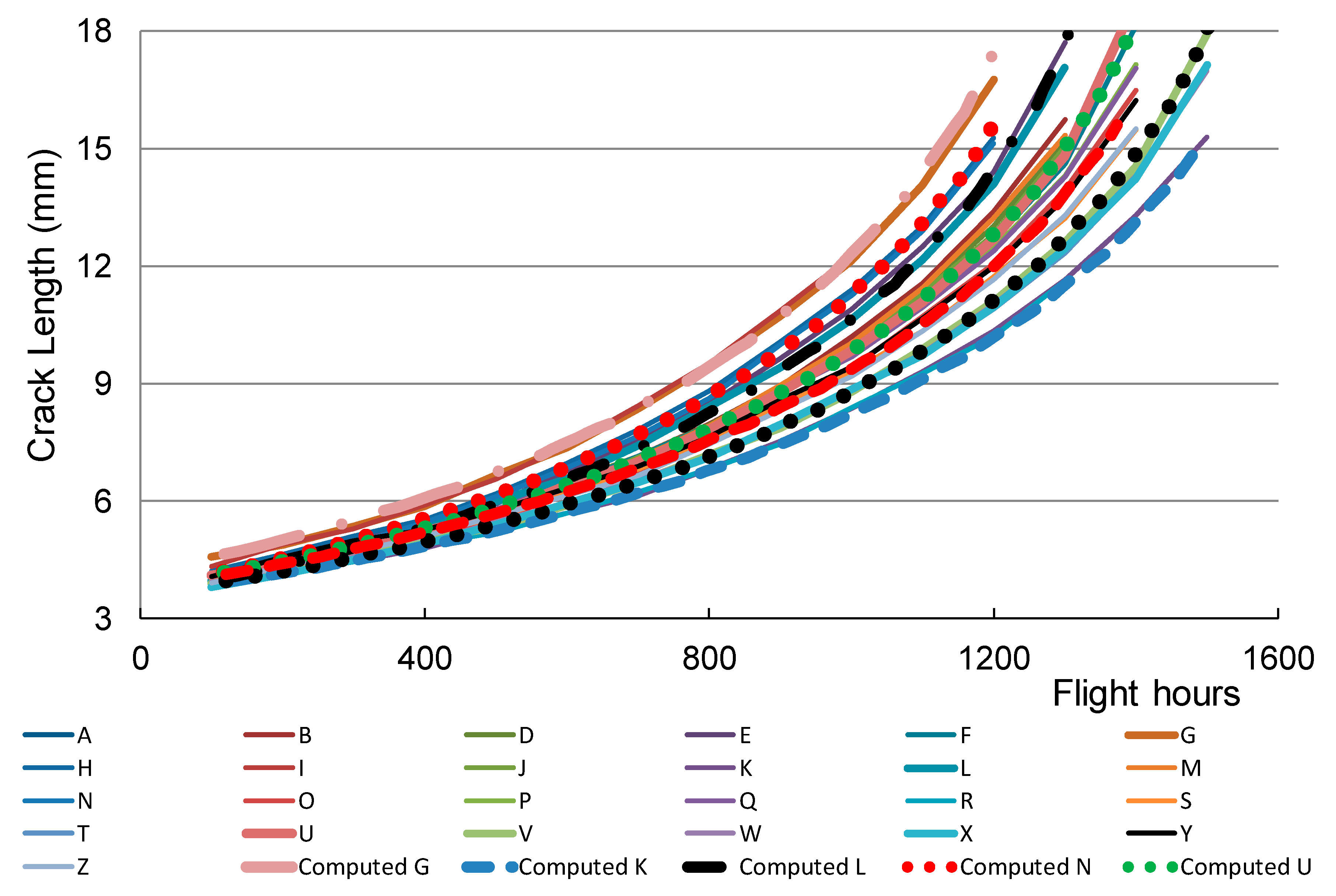

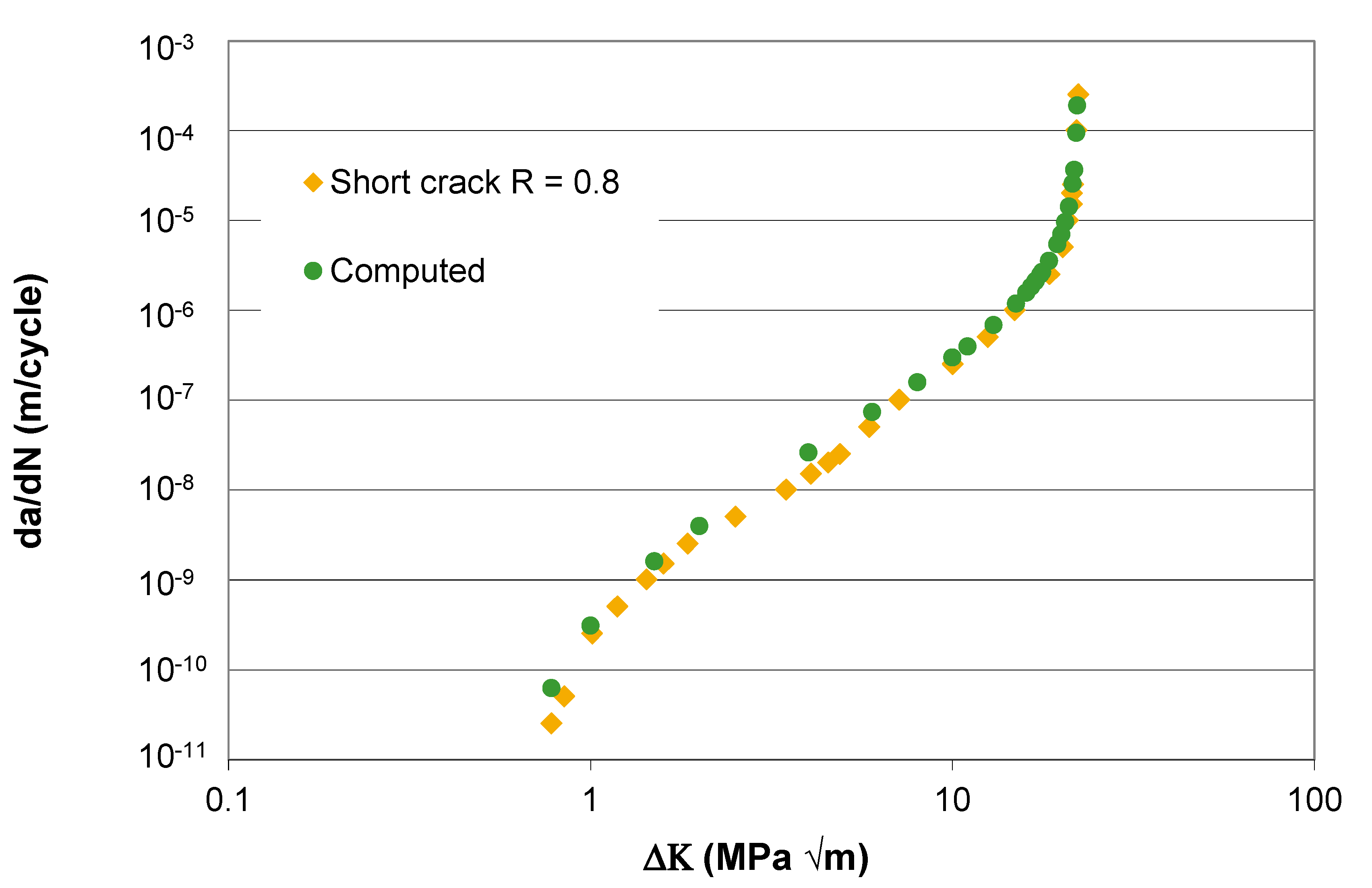
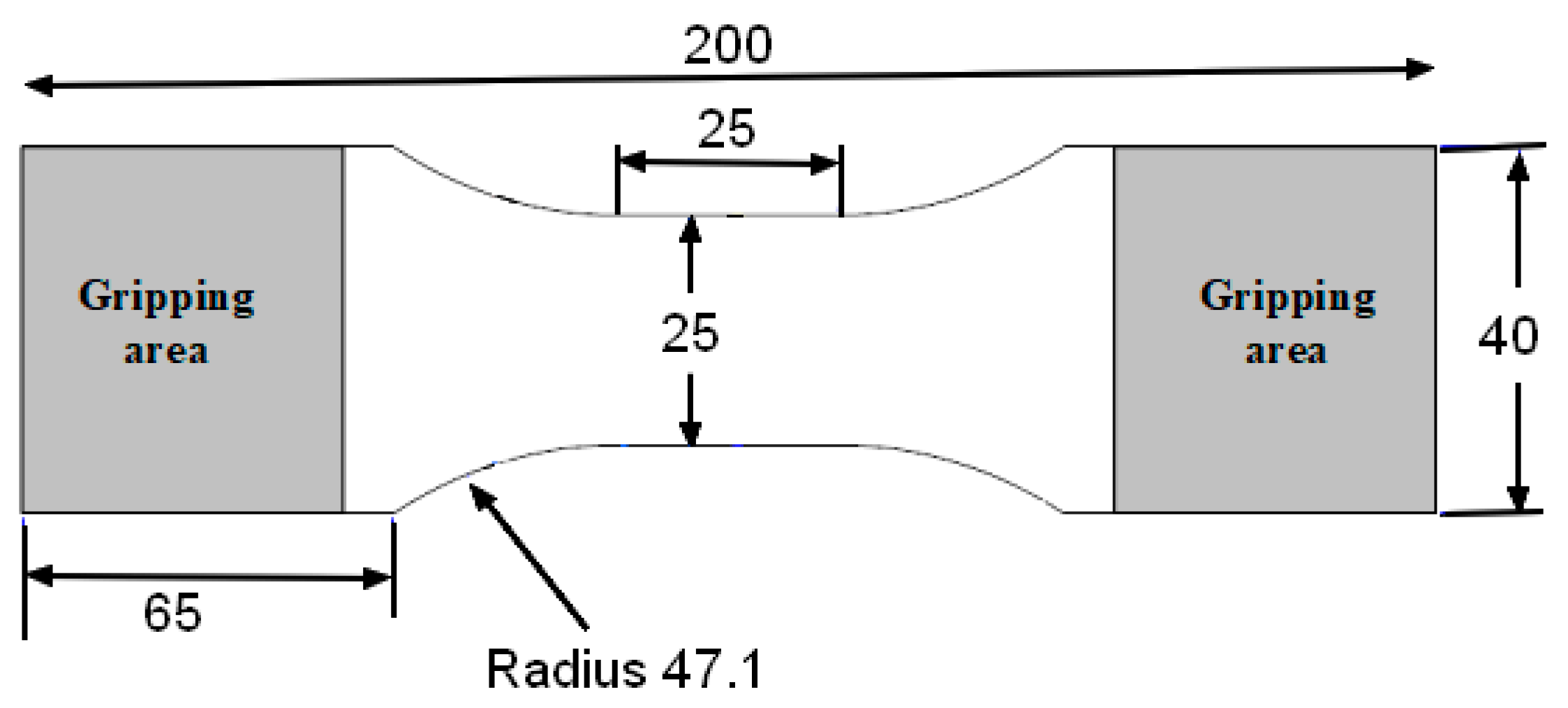
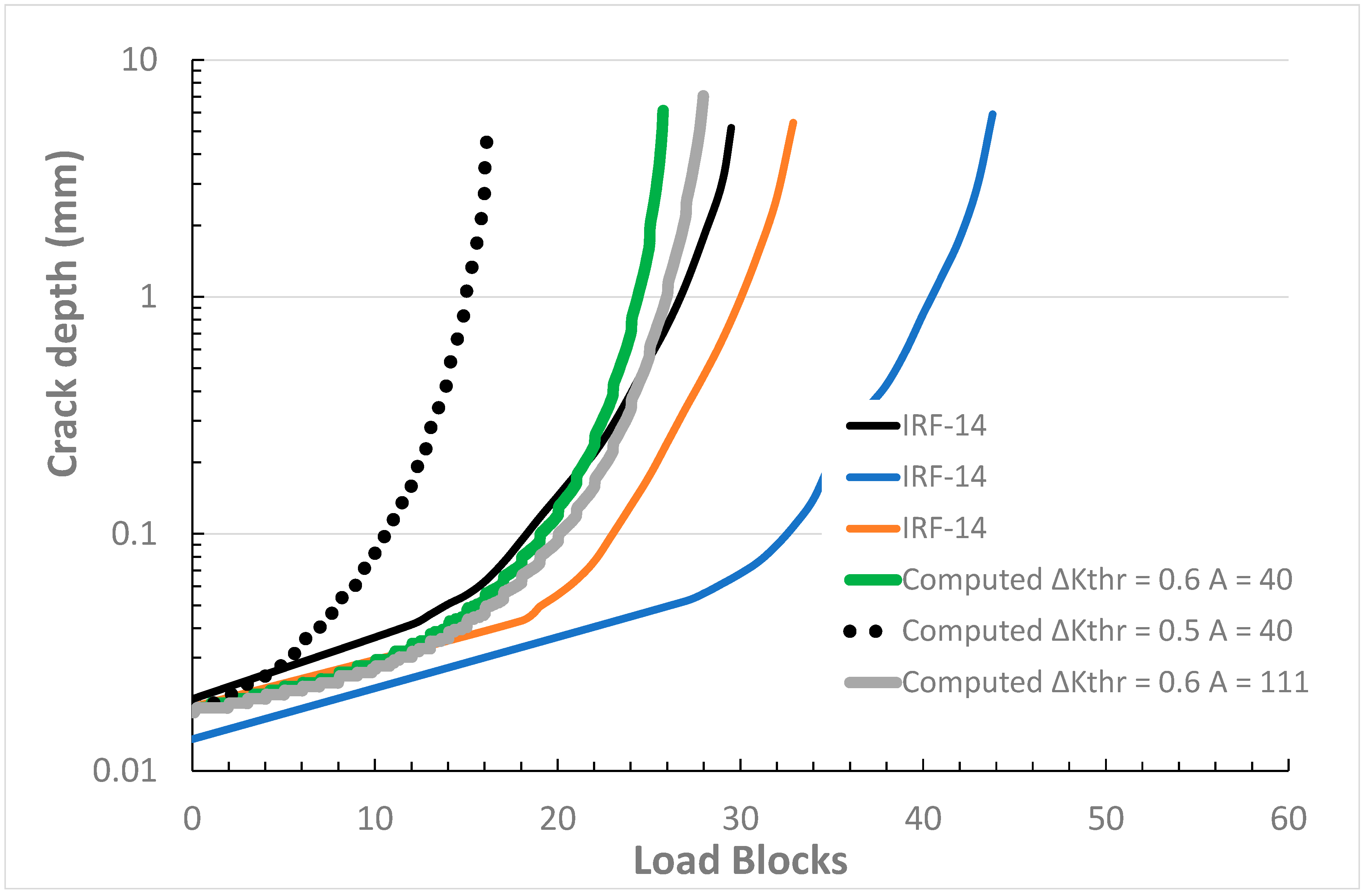
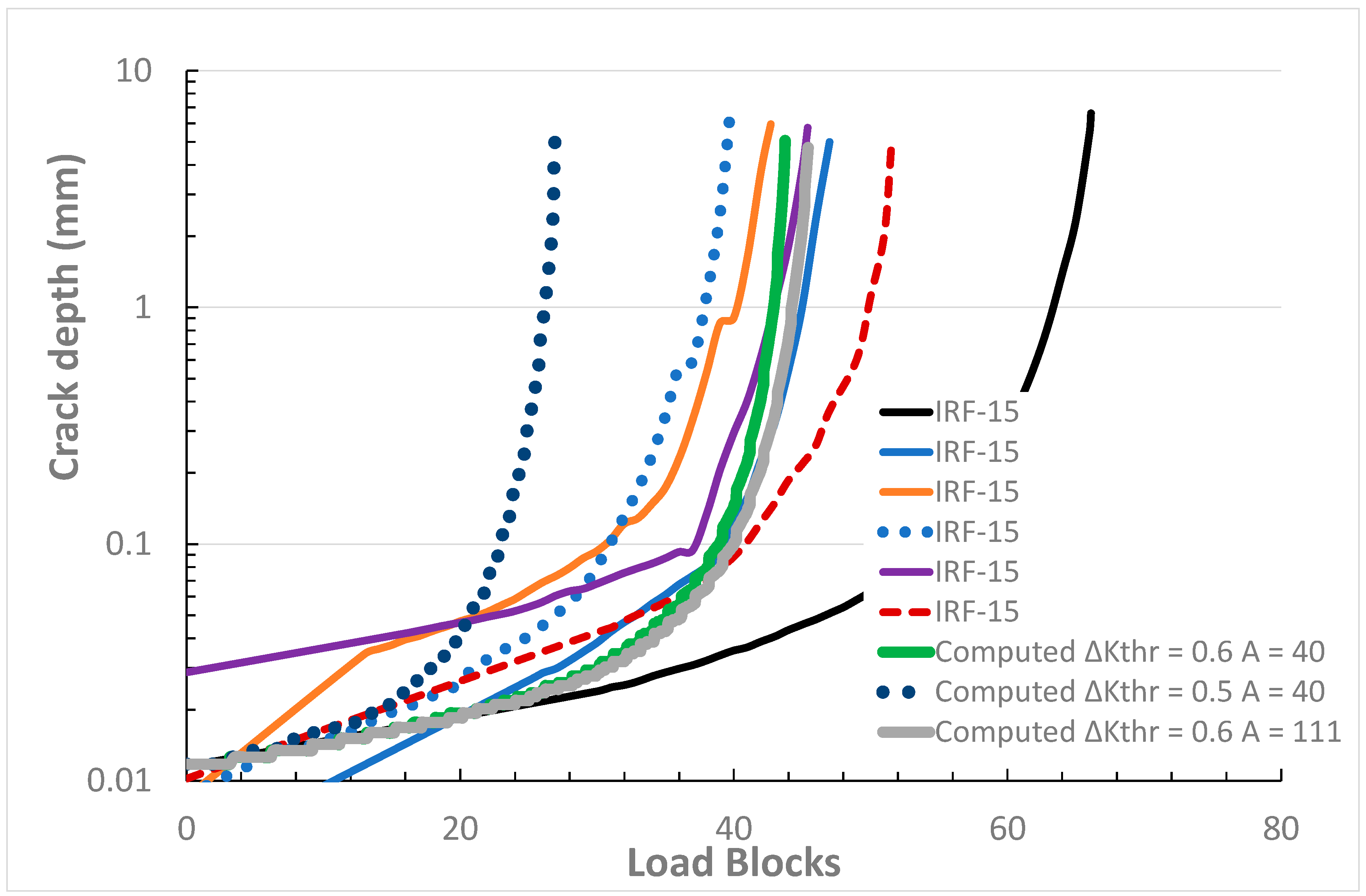
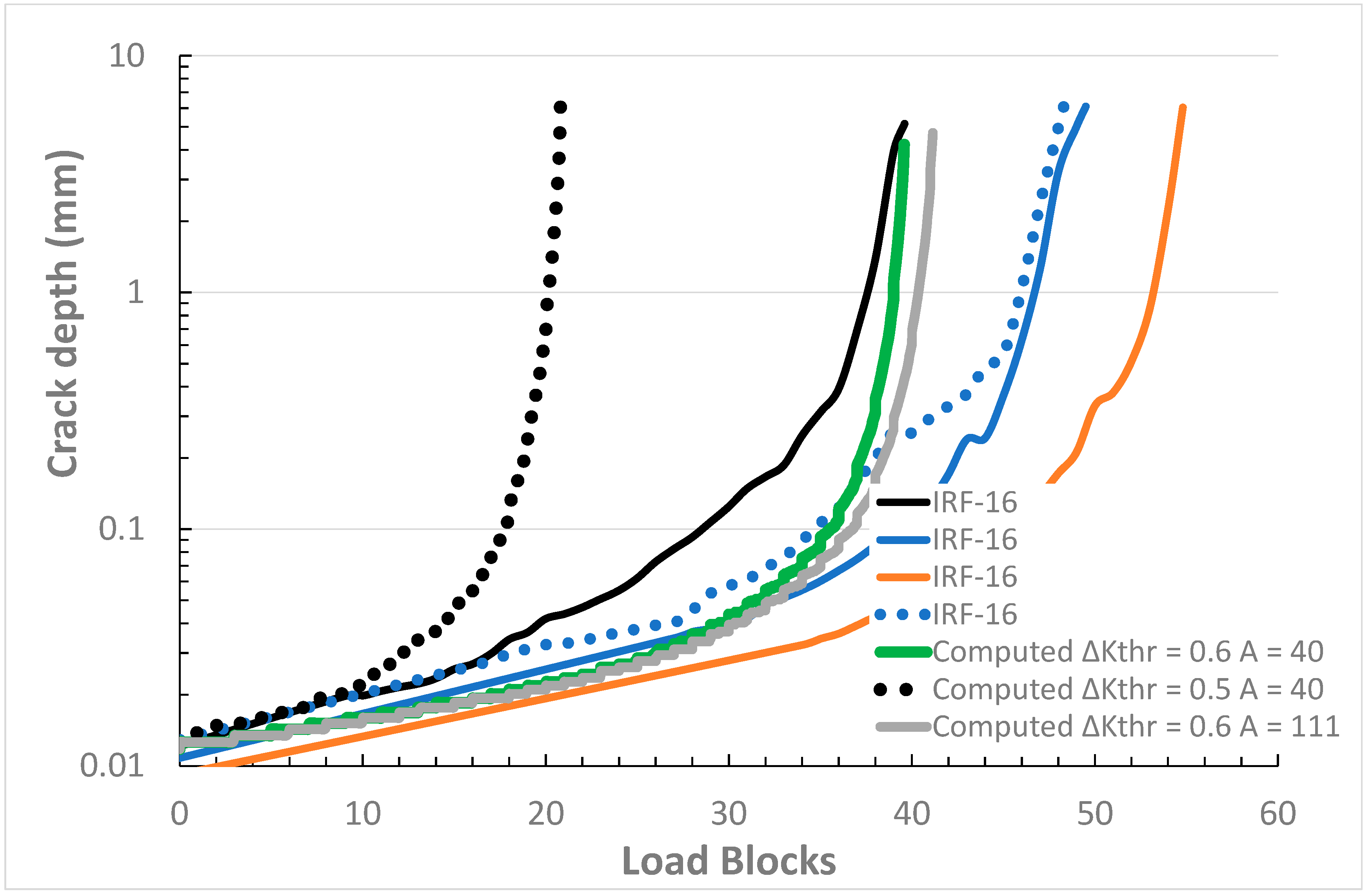
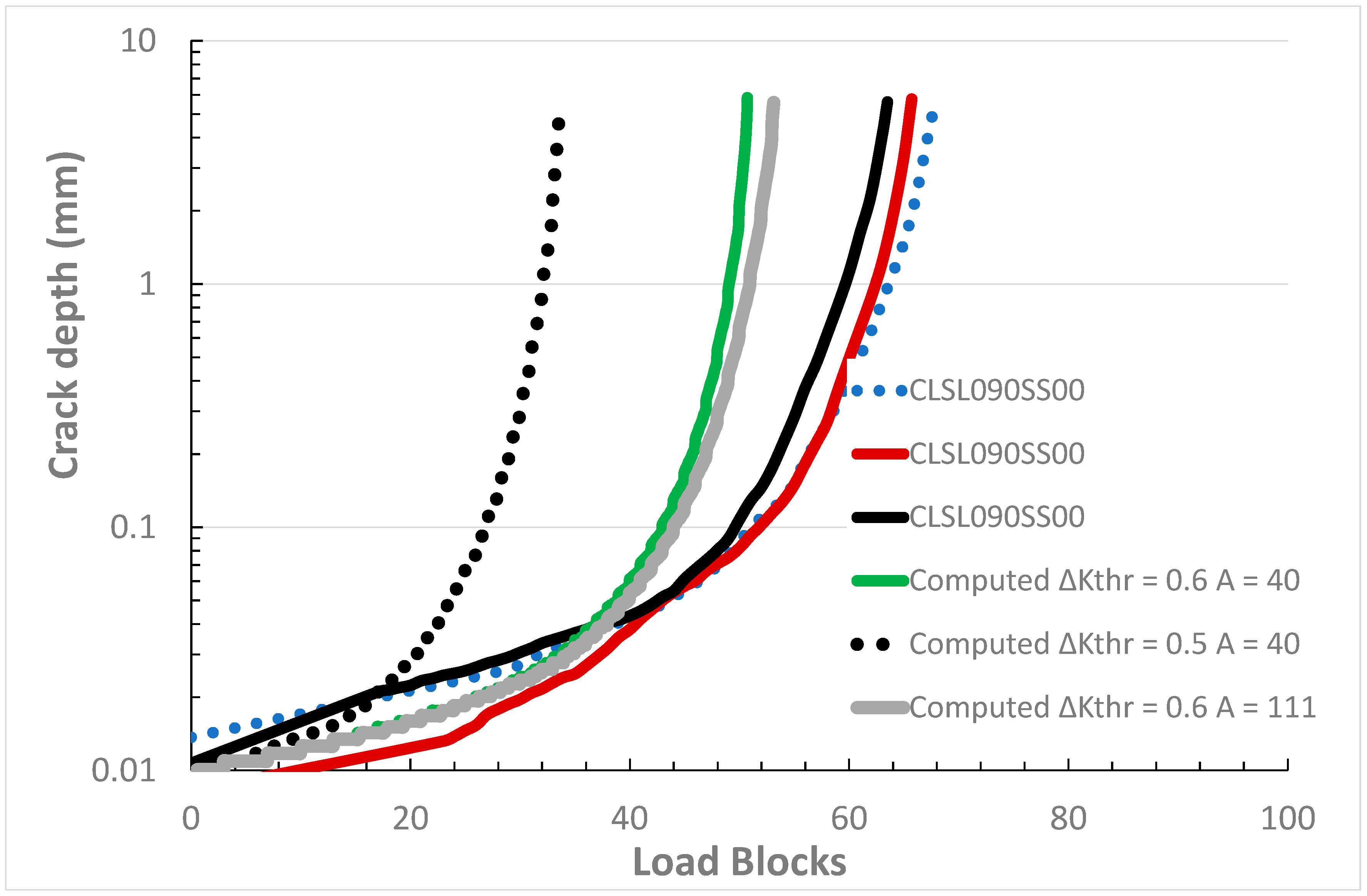





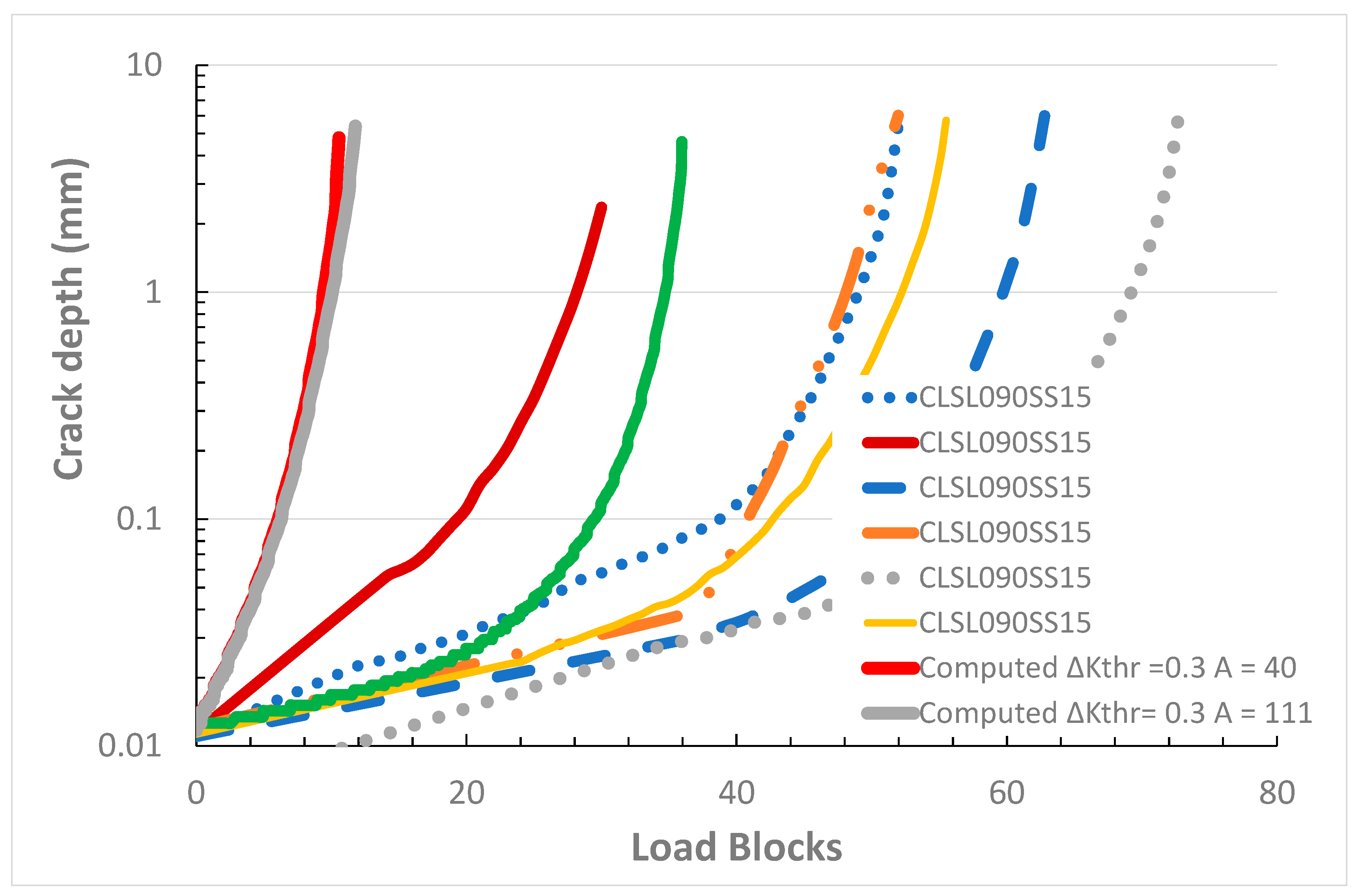
| Test | A (MPa √m) | ∆Kthr (MPa √m) |
|---|---|---|
| G | 111 | 1.3 |
| K | 111 | 1.79 |
| L | 111 | 1.1 |
| N | 111 | 1.1 |
| U | 111 | 1.48 |
| V | 111 | 1.6 |
| X | 111 | 1.45 |
| Y | 111 | 1.6 |
| G | 111 | 1.3 |
| IRF-E15 | IRF-E15 | IRF-E16 | CSL090SS00 | CSL090SS05 | CSL090SS15 | CSL090SS20 |
|---|---|---|---|---|---|---|
| 82,839 | 248,255 | 649,666 | 64,958 | 64,958 | 64,958 | 64,958 |
| Measured/Computed | IRF-E15 Load Blocks to Failure | CSL090SS15 Load Blocks to Failure |
|---|---|---|
| Smallest test life | 38.3 | 32.0 |
| Longest test life | 66.1 | 72.7 |
| Mean life | 46.8 | 54.5 |
| Standard deviation (σ) | 10.4 | 13.6 |
| Mean-3σ | 15.6 | 13.8 |
| Computed ΔKthr = 0.3 MPa √m, A = 40 MPa √m | 8.9 | 12.7 |
| Computed ΔKthr = 0.3 MPa √m, A = 111 MPa √m | 9.7 | 13.2 |
© 2020 by the authors. Licensee MDPI, Basel, Switzerland. This article is an open access article distributed under the terms and conditions of the Creative Commons Attribution (CC BY) license (http://creativecommons.org/licenses/by/4.0/).
Share and Cite
Jones, R.; Peng, D.; Raman, R.K.S.; Huang, P. Computing the Growth of Small Cracks in the Assist Round Robin Helicopter Challenge. Metals 2020, 10, 944. https://doi.org/10.3390/met10070944
Jones R, Peng D, Raman RKS, Huang P. Computing the Growth of Small Cracks in the Assist Round Robin Helicopter Challenge. Metals. 2020; 10(7):944. https://doi.org/10.3390/met10070944
Chicago/Turabian StyleJones, Rhys, Daren Peng, R.K. Singh Raman, and Pu Huang. 2020. "Computing the Growth of Small Cracks in the Assist Round Robin Helicopter Challenge" Metals 10, no. 7: 944. https://doi.org/10.3390/met10070944
APA StyleJones, R., Peng, D., Raman, R. K. S., & Huang, P. (2020). Computing the Growth of Small Cracks in the Assist Round Robin Helicopter Challenge. Metals, 10(7), 944. https://doi.org/10.3390/met10070944







